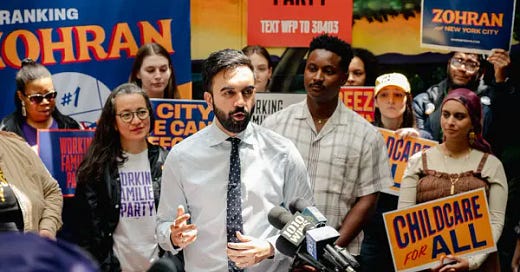On Tuesday, June 24th, Zohran Mamdani overwhelmingly triumphed in the New York City Mayoral Primary– a feat unheard of for a candidate polling in the single digits just a few months ago. By the time the election was officially called the following week, Mamdani had secured a whopping twelve-point lead over his primary opponent, Andrew Cuomo.
Cuomo, son of former New York Governor Mario Cuomo and long front-runner of the primary election, had focused his campaign on typical issues run by mayoral candidates– safety in subways and on the streets, accessible education, and affordability. Cuomo earned backing from major faces of the Democratic party, including Bill Clinton and former Mayor Michael Bloomberg, and secured much of his funding from several former Trump donors. Just one month before election day, polls showed Cuomo with an eleven point lead on Mamdani.
Meanwhile, as a self proclaimed democratic socialist, Mamdani is running his campaign on economic relief: promising to freeze the rent on all rent-stabilized units, eliminate fare for city buses, and provide free care for children between six weeks and five years of age. The homepage of his campaign website features bright colors and playful fonts, coupled with a single sentence: “Zohran Mamdani is running for Mayor to lower the cost of living for working class New Yorkers.”
For many Democrats, Mamdani’s win may be attributed to the momentum that his social media garnered. With almost 700,000 TikTok followers by Election Day, Mamdani had amassed roughly one hundred times that of Cuomo.
But, to accredit Mamdani’s win to his social media presence would be to fundamentally misinterpret the hard work and meticulous strategy of his campaign. Knocking on over 1.5 million doors by the time the polls had closed and conducting campaign videos in languages like Hindi and Spanish, Mamdani reached an unprecedented number of first-time or uninformed voters. Moreover, Mamdani maintained a constant presence in the streets, regularly walking the 13.4 mile length of Manhattan and visiting isolated neighborhoods to meet constituents face-to-face. Just one hour before the polls closed on the night of the primaries, Mamdani posted several videos with constituents that had committed to vote for him just moments prior. These in-person efforts were critical to win new voters, particularly those not on social media or frequently consuming political content. Each of these efforts were ones that Cuomo had failed to partake in as aggressively.
Capturing voters’ attention was only half the battle, though. Despite Cuomo and his allies pinning Mamdani as a radical leftist candidate for his Democratic Socialist policies, Mamdani centered his campaign on the greatest issue plaguing the City– affordability. He exemplified his commitment to an affordable New York City by championing easy-to-remember slogans; “Freeze the rent,” “Make buses fast and free,” and “Deliver universal childcare,” quickly became cornerstones of his rhetoric. At his rallies, Mamdani would lead his supporters in a call-and-response of these promises– representing his way of holding himself accountable for the change he sought to bring.
By centering his campaign on affordability, prioritizing face-to-face connection, and utilizing clear messaging, Mamdani was able to win numerous Trump voters across all five boroughs, despite being considered the most progressive candidate on the ballot while his Cuomo was backed by Trump’s very donors.
The recent Arizona 7th Congressional District special election primary featured many parallels to the New York City Mayoral Primary. With the would-be Democratic incumbent, Raúl Grijalva, passing away in early 2025, Grijalva’s daughter has stepped up in pursuit of his place. Running on a platform similar to that of her father, Adelita Grijalva has promised her constituents to defend federal services like Medicare, Medicaid, Social Security, and the Veterans Administration, create affordable housing, and fund the public education system– each supported by detailed policy plans for how she will do so. Grijalva also received endorsements from influential progressives, including Bernie Sanders and AOC, but notably lacks a significant social media following.
Conversely, Grijalva’s biggest opponent was Deja Foxx: a twenty-five year old political content creator and former Kamala Harris staffer. Harnessing her extensive social media experience, Foxx quickly went viral nationwide with several million likes across her accounts. But, many Arizonans felt that her campaign lacked sincerity and actionability– Foxx quickly became known for a focus on her own story, rather than her policy views. Interviews, public appearances, and social media posts were characterized by the same line: “I was raised by a single mom in Section 8 housing, and we relied on food stamps and Medicaid.”
Meanwhile, her stances remained lackluster at best. Though Foxx centered her campaign around her identity as a former welfare recipient, she failed to provide substantive policy plans for how she would protect these very programs.
This is precisely why Grijalva prevailed in July 15th’s primary election, winning by an astronomical forty-point margin. Despite a lack of a large social media platform, Grijalva offered her constituents with specific, actionable solutions to the problems that they face. To voters, solvency was worth far more than story.
From New York City to Arizona Congressional District 7, constituents have demonstrated that youth and virality are not the keys to political success. Rather, candidates must provide explicit policy plans for how they will tackle issues facing their community. Just as Mamdani explained to New Yorkers precisely how he’d lower the cost of living, Grijalva detailed the avenues that she’d take to protect Arizonans from rising prices. Ultimately, social media engagement doesn’t equate to voter support– substance and strategy does.









